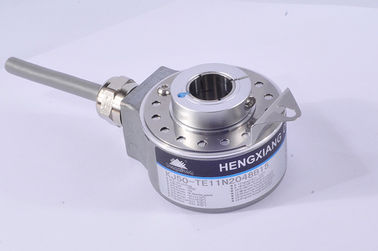

KJ50 hollow shaft absolute encoder single turn gray code output 8 bit dc8-30v for sensor
Our Service
Product Basis information
| Supply voltage | DC5V ; DC8-30V |
| Outlet type | Radial cable |
| Radial socket | |
| Radial cable with plug | |
| Count direction | counterclockwise |
| outside control direction | |
| clockwise | |
| Interface | NPN low level effective |
| NPN high level effective | |
| Protection grade | IP50 ; IP65 |
| Cable length | 1M (cable length could be added appropriately by |
| require, but it need payment individually) | |
| Consumption current | 100mA MAX |
| Top response frequency | 100KHZ |
| Allowable ripple | ≤3%rms |
| Load Voltage | ≤DC30V |
| Output code | gray code |
| Precision | 360/(resolution x 4) |
| Insulation strength | AC500V 60s |
| Shaft Material | Stainless steel |
| Shell Material | die cast aluminum |
| Cable length | 1000mm(cable with shielding) |
| Certification | CE |
| package | Carton box |
| Net weight | About 310g (with package) |
Payment terms:
1. T/T, western union, credit card, Paypal, etc
2. 3-5 working days after payment received
3. Encoders will be shipped once ready
Shipment
![]()
About Absolute encoder
Absolute encoders have an encoder disc (sporting marks or slots) on a power-transmission shaft and a stationary pickup, but the disc marks output a unique code for each shaft position. Absolute encoders are either single-turn or multi turn encoders. Single turn absolute encoders can verify position within a single turn of the encoder shaft. This makes them useful for short travel situations. In contrast, multiple-turn absolute encoders are better for more complex or longer positioning situations.
Engineers generally classify absolute encoders by the number of their output bits, which correlates to the number of the disc’s tracks—and the maximum rotary angle the encoder registers. More after the jump.
Absolute rotary encoders have the advantage of non-volatile memory. That is, they do not lose track of positioning even when power fails. So even if something moves the machine shaft when power is off, an absolute encoder keeps track of the rotary-position change when the machine powers on again. Usually, electronics store this information as binary code, ideally Gray binary code. Absolute rotary encoders can operate point-to-point as well. They are useful in situations where safety is a concern, because they position whenever machines power on. Immunity to electoral noise is another benefit. One caveat: absolute rotary encoders are generally more expensive than incremental encoders. However, the cost of absolute encoders has steadily decreased over the last decade, and that’s driven steady increase of their use.
Applications